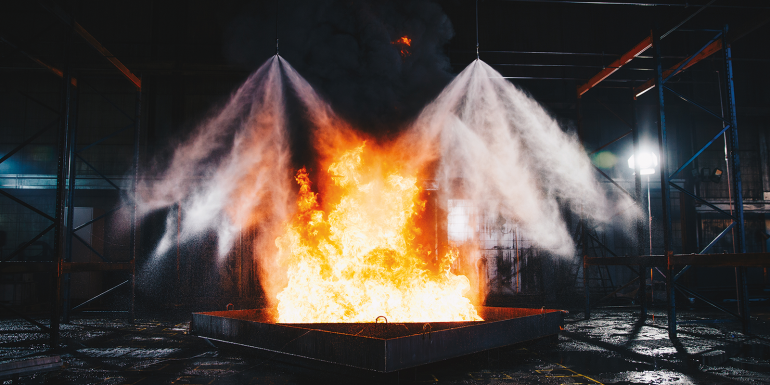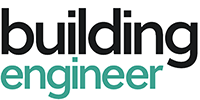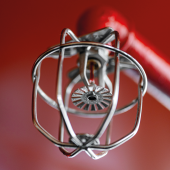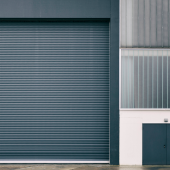An overview of water-mist fire protection systems

BAFSA provides an overview of the technology, standards and applications of water-mist fire protection systems.
Over the past 30 years, water-mist technology has increasingly been recognised as an effective method for protecting buildings and their occupants from fire hazards.
This article serves as a comprehensive guide to understanding what mist systems can and cannot do, current technological advancements and the standards to which these systems should be designed and installed. It aims to assist those looking to procure, specify or approve water-mist systems.
One of the principal benefits of water-mist systems is their ability to overcome water supply or storage constraints. Unlike traditional sprinkler systems, which rely on specific water application rates and density, water-mist systems are designed based on the layout of the nozzles, the number of nozzles within the design area and the respective pressure and K-factor (volumetric flow rate) at those nozzles.
The water supply is determined by the most favourable hydraulic calculation, considering either the maximum number of nozzles within the design area or the maximum pressure at which they are subjected.
Water-mist fire suppression systems utilise fine droplets of water to control, suppress or extinguish fires. These systems have gained popularity due to their efficiency in reducing fire damage and their suitability for various applications. Unlike traditional sprinkler or gas extinguishing systems, water-mist technology is highly specific to the premises, application and the manufacturer.
Water-mist technology has also seen significant advancements over the past three decades. Innovations in nozzle design, water delivery systems and droplet size optimisation have enhanced the performance of water-mist systems and expanded the range of applications, making it a viable option for residential, commercial and industrial settings.
Standards and specs
The standards governing water-mist fire suppression systems are undergoing substantial changes. The new European norm (EN) standard for residential water-mist systems, EN 14972-17, is set to be published as a BS EN by summer 2025. This new standard will necessitate the withdrawal of BS 8458 within approximately six months of its publication. Additionally, Warrington FIRAS, which certifies many water-mist installers, has closed its schemes. Certificates issued under Annex C of BS 8458 will no longer be valid after 31 August 2025.
The primary design objectives for all fire suppression systems, including water mist, are to extinguish, suppress or control fires. Each water-mist manufacturer employs proprietary technology to maximise the efficiency and effectiveness of water droplet deployment. This technology varies depending on the manufacturer and the specific application, affecting both the nozzle design and the means of water delivery.
Each hazard or occupancy type requires a very specific design, detailed in the manufacturer’s design, installation, operation and maintenance (DIOM) manual. This specificity ensures that the system is tailored to effectively address the particular fire hazards associated with the environment in which it is installed.
Water supply and storage
Water-mist systems require less water storage compared to sprinkler systems; some high-pressure water-mist systems may not require any storage at all. This reduced water requirement can be a significant benefit in domestic and residential applications, where space may be limited.
Lower water application rates also help minimise collateral damage caused by water following a fire. This can be particularly important in residential settings, where water damage can be costly and disruptive.
Water-mist systems are especially beneficial in the protection of historic and heritage buildings and their contents. These systems are often retrofitted and their design using small-bore pipes makes them easier to install with minimal damage to the heritage fabric of the building structure. Additionally, they are usually less visually intrusive, preserving the aesthetic integrity of the protected structures.
The National Annex B to BS EN 14972-1 provides a comprehensive list of essential items that must be included in the DIOM documentation for water-mist systems. This guide ensures the effective planning, implementation and ongoing operation of these fire suppression systems. Below is an in-depth overview of each critical item to be included in the DIOM:
- general information – this section should provide a thorough description of the type of water-mist system being used. It includes details about the system’s purpose and scope, and the specific applications it is designed for
- limits of application – the DIOM must specify the limitations of the system, including maximum installation heights, ventilation requirements and potential obstructions that could affect system performance
- description of components – a detailed description of all components of the water-mist system should be provided, along with the standards to which they are designed. This ensures that each part meets the necessary specifications and quality standard
- testing of specific systems – this section should include information on the testing protocols used for the specific system/s, details of the fire test protocols and the results of such tests. This ensures that the system has been rigorously tested and is capable of performing effectively in fire scenarios
- approvals and certifications – documentation of all approvals and certifications gained for the systems and their components must be included. This demonstrates compliance with relevant regulations and standards
- declaration of conformity – a declaration of conformity to applicable product safety directives should be included to affirm that the system adheres to necessary safety guidelines
- planning and design – this section should outline the planning and design process, including any specific qualifications or approvals needed by the designer. It ensures that the system is designed by competent professionals
- nozzle spacings and pressures – information on the maximum and minimum spacings for nozzles, as well as the required working and standby pressures, should be provided. This ensures optimal performance and coverage
- minimum design area – the DIOM must specify the AMAO (assumed maximum area of operation) and the minimum number of nozzles required in this area. This is crucial for ensuring adequate fire suppression coverage
- discharge duration – details on the discharge duration per application should be included to ensure that the system can effectively combat fires for the necessary amount of time
- water supply requirements – should include details of acceptable water quality. Reliable water supply is essential
- installation process – a detailed description of the installation process should be provided to ensure that the system is installed correctly and safely
- testing and commissioning – information on the testing and commissioning process should be included to confirm that the system has been properly set up and is ready for use
- inspection and audit – the DIOM should outline the procedures for regular inspection and audit to ensure ongoing compliance and performance
- maintenance – details on the maintenance requirements and schedules should be included to ensure that the system is in good working order
- typical hazards – this section should describe the typical hazards applicable to the fire testing, including fire type and maximum fire loads. This helps in understanding the system’s effectiveness in various scenarios
- hazard description – a detailed description of the specific hazards the system is designed to protect against should be provided
- fire loads tested – information on the types and sizes of fire loads that have been tested should be included to demonstrate the system’s capabilities
- nozzle K-factor – the K-factor for each nozzle should be specified to ensure proper hydraulic calculations and system design
- interaction with other fire systems – details on how the water-mist system interacts with other fire systems – such as detection, alarm and smoke control systems – should be provided to ensure comprehensive fire protection
- installation requirements – when installing water-mist systems in residential premises (particularly in Wales), it is essential to provide documentation that demonstrates compliance with the relevant requirements. This includes detailed information on the design area, the number of nozzles within the design area and the working tank capacity
- design considerations – a frequent observation during third-party audits of water-mist designs is that contractors may not correctly determine the design area or the number of nozzles within it. Additionally, the effect of hydraulic gradient is often overlooked. Proper consideration of these factors is crucial for the effective functioning of the system
- tank capacity – contractors should ensure that they use accurate calculations for the working tank capacity required for the system. Relying on gross tank capacities can lead to inefficiencies and potential system failures. It is essential to base these calculations on the specific needs of the water-mist system in question; and
- documentation and compliance – to ensure compliance with the regulations, detailed documentation must be provided. This should include the following information:
- the design area and the number of nozzles within it
- the hydraulic calculations used to determine the water supply
- the working tank capacity required for the system; and
- any considerations related to the hydraulic gradient.

High-pressure water-mist fire suppression systems need less water storage in comparison to sprinkler systems
Challenges
One of the challenges faced by water-mist systems is the low level of interoperability between components from different manufacturers. This lack of standardisation can lead to significant issues throughout the lifespan of the system, complicating maintenance and upgrades.
It is also the case that the supporting standards and certification schemes for water-mist technology are still evolving. As the industry continues to develop these protocols, it is essential to stay informed about the latest advancements to ensure compliance and optimal performance.
Water-mist systems offer numerous benefits, particularly for residential premises. These include reduced water storage requirements, minimised collateral damage and enhanced protection for historic and heritage buildings. Proper installation and accurate documentation are essential to ensure compliance with regulations and the effective functioning of the system. By adhering to these guidelines, homeowners and contractors can take full advantage of the advantages that water-mist systems provide.
For a more detailed guide on water-mist systems, BAFSA’s technical guide is available for free download at b.link/BAFSA_resources
List of current standards and certifications
BS EN 14972: Fixed firefighting systems. Water mist systems
- 14972-1 Design, installation and maintenance of water mist systems
- 14972-2 for shopping areas
- 14972-3 for offices, school classrooms and hotels
- 14972-4 for non-storage occupancies
- 14972-5 for car garages
- 14972-6 for false floors and false ceilings
- 14972-7 for low hazard occupancies
- 14972-8 and -9 machinery spaces
- 14972-10 atrium protection
- 14972-11 for cable tunnels
- 14972-12 commercial deep fat fryers
- 14972-13 for wet benches
- 14972-14 and -15 combustion turbines
- 14972-16 for industrial oil cookers
- 14972-17 for residential occupancies
BS EN 17450: Fixed firefighting systems – Water mist components
Part 1:2021 – Product characteristics and test methods for strainer and filter components
- prEN 17450-2 nozzles
- prEN 17450-3 check valves
- prEN 17450-4 control deluge valves and actuators
- prEN 17450-5 pressure switches
BS 8458: 2015 Fixed fire protection systems – residential and domestic watermist systems – code of practice for design and installationBS 8489: Fixed fire protection systems – Industrial and commercial watermist systems
Part 1:2016 – Code of practice for design and installation
Part 4:2016 – Fire performance tests and requirements for watermist systems for local applications involving flammable liquid fires
Part 5:2016 – Fire performance tests and requirements for watermist systems for the protection of imbustion turbines and machinery spaces with volumes up to and including 80m3
Part 6:2016 – Fire performance tests and requirements for watermist systems for the protection of industrial oil cookers
Part 7:2016 – Fire performance tests and requirements for watermist systems for the protection of low hazard occupancies
BS 8663: Fixed fire protection systems – Components for watermist systems
Part 1:2019 – Specification and test methods for watermist nozzles
Image credit | iStock | HI FOG by Marioff









